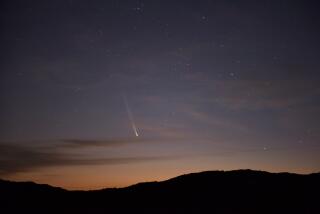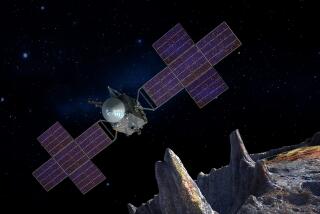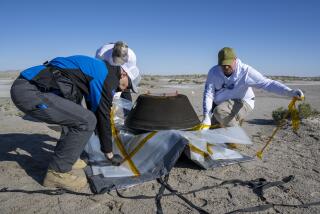Collecting Dust
The first spacecraft designed to capture dust from a comet and return it to Earth is set for launch Saturday afternoon in a mission to explore what conditions were like at the very beginnings of the solar system.
Cobbled together from leftover components of earlier spacecraft, along with a remarkable new dust-collecting material often called “solid smoke,” the Stardust probe will rendezvous with comet Wild-2 in January 2004.
Flying through the comet’s coma at a relatively slow speed, Stardust will capture more than a million grains of dust, returning them for a parachute landing in the Utah desert on Jan. 15, 2006.
Comets like Wild-2 contain “the stuff life is made of”--water and organic molecules--said Carl Pilcher, NASA’s science director for solar system exploration. The Stardust mission “is extremely important, not only for studying the origins of life on Earth, but also the biological potential of other planets, “ he said.
The probe’s dust collector will gather interstellar dust--literally dust blown into space by other stars--both on its way to the rendezvous and on the return trip, providing astronomers with their first samples of material from outside the solar system.
“It’s been 34 years since the last samples came back” from the moon, said astrophysicist Donald Brownlee of the University of Washington, the mission’s principal investigator. “It’s very exciting to be back in the sample-return business.”
Comets are the oldest, most primitive bodies in the solar system, preserving the materials that were present in the nebula that formed the sun and its planets 4.6 billion years ago.
They often are called dirty snowballs because they are made up of dust, ice and complex organic molecules. The term “organic” means that such molecules contain carbon, not necessarily that they come from living organisms.
Astronomers estimate that as many as 10 trillion comets still circle the sun in the Oort Cloud, far beyond the orbit of Pluto. Passing stars occasionally disturb the orbits of individual comets, causing them to plunge sunward, where heat and radiation pressure produce massive glowing tails.
Some comets are ejected into interstellar space after such a plunge. Others, such as Halley’s comet, enter solar orbits of varying lengths. Because part of the comet boils away on each passage, a single comet usually makes only about 1,000 orbits before literally vaporizing into nothingness.
Comet 81P/Wild-2, named after discoverer Paul Wild (pronounced Vilt), provides a unique opportunity for astronomers because it has spent most of its life beyond the orbit of Jupiter and thus has lost little of its original matter through outgassing.
On Sept. 10, 1974, however, it passed close to Jupiter and was shifted into a new orbit that carries it between the orbits of Jupiter and Mars. Just 2 1/2 miles in diameter, it is visible only with a telescope, even on its closest approach to the sun.
Most important, “it has an extremely favorable orbit,” said Ken Atkins, Stardust project manager at Caltech’s Jet Propulsion Laboratory. “We can get to it and back with very low energy.”
That orbit also means that the probe can go by the comet relatively slowly, providing a longer observation time.
Stardust will pass within 91 miles of Wild-2 at a relative speed of 6.1 kilometers per second, about 13,000 mph. By contrast, probes sent to Halley’s comet on its last appearance passed by at 79 kilometers per second and did not get nearly as close.
The 848-pound craft, about the size of a standard office desk, carries cameras and instruments to photograph the comet and analyze the composition of the dust it encounters during transit and at the comet. More important is the collector. The heart of the device is a silicon-based material called aerogel--a sponge-like glass that is 99.8% air and 39 times more insulating than the best fiberglass insulation.
But it is strong enough to stop dust particles traveling at up to six times the speed of a bullet fired from a high-powered rifle, slowing them so gently that the samples are not degraded. Each time a grain of dust hits the transparent aerogel, it will bury itself, leaving a carrot-shaped track that will show investigators where the particle stopped its motion.
The aerogel is mounted in trays on both sides of a tennis-racquet-shaped arm that will be raised above Stardust. On the outgoing and return trips, dust will be collected on one side of the device. As the craft nears Wild-2, the arm will be raised again to collect comet dust on the device’s backside.
The team expects to collect more than a million particles ranging in size from about one micron (1/25,000th of an inch, or about 1/50th the width of a human hair) up to 100 microns (about 1/250th of an inch).
Researchers expect to collect about 1 milligram of comet dust, less than a thimbleful. By contrast, the Apollo missions brought back 842 pounds of moon rock.
The Stardust capsule, built by Lockheed Martin Corp., will enter the Earth’s atmosphere at 28,000 mph, about 4,000 mph faster than the Apollo capsules. A specially developed heat shield protects the capsule as it is slowed by friction in the atmosphere. Parachutes then bring it to a gentle landing in Utah.
Because of the constraints of its orbital mechanics, Stardust has about a 1-second window for launch Saturday or, if that fails, on each day for the rest of the month. If it is not launched by the end of February, the team will be forced to abandon the mission.
*
Further information and updates from the mission are available at: https://www.jpl.nasa/stardustnews and https://stardust.jpl.nasa.gov
(BEGIN TEXT OF INFOBOX / INFOGRAPHIC)
Comet Cleanser
The Stardust spacecraft, to be launched Saturday, will loop around Earth to get a gravity boost before intersecting the orbit of comet Wild-2, where it will collect cometary dust. It will then return to Earth in January 2006, when the sample container will be parachuted to a landing site in Utah.
1. Spacecraft is launched from Kennedy Space Center on Saturday and begins first loop.
2. Swings around Earth for a gravity boost Jan. 15, 2001, and begins second loop.
3. Collects interstellar dust March-May 2000 and July-December 2002.
4. Encounters Wild-2 comet Jan. 2, 2004, and collects comet dust as it speeds past.
5. Samples are parachuted to Utah desert landing site Jan. 15, 2006.






